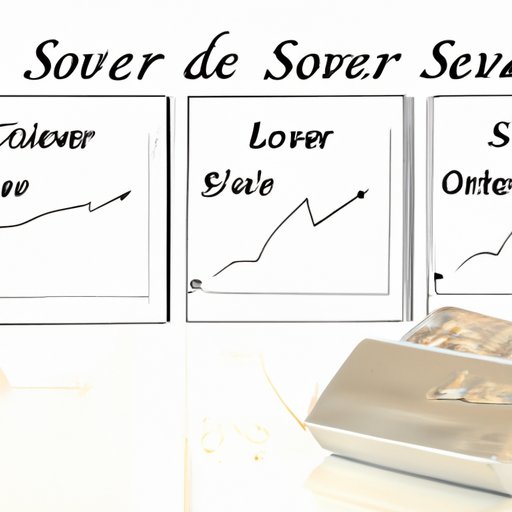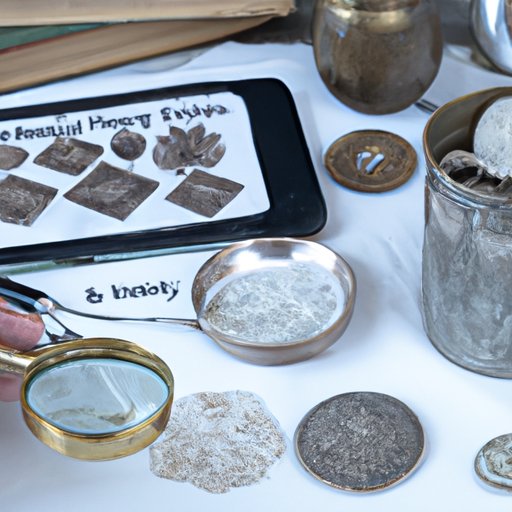Introduction
Investing in silver has become increasingly popular in recent years as investors look for ways to diversify their portfolios. Silver is an attractive option because it offers potential for high returns, as well as diversification benefits. However, there are also risks associated with investing in silver, so it is important to understand both the pros and cons before making any investment decisions.

Analyzing the Pros and Cons of Investing in Silver
Before investing in silver, it’s important to weigh the potential benefits against the potential risks. Here is a closer look at both sides of the equation:
Potential Benefits
There are several potential benefits to investing in silver. These include:
Potential for High Returns
Silver prices can fluctuate significantly, meaning that investors have the potential to earn large returns if they make the right investments. Of course, this also means that there is the potential to lose money as well, so caution should always be taken when investing in silver.
Diversification Benefits
Silver is a precious metal, which means that its price is not directly linked to stocks and other traditional investments. This makes silver a good option for diversifying a portfolio, as it provides exposure to different asset classes. This can help to reduce some of the risk associated with investing.
Potential Risks
In addition to the potential benefits, there are also some risks associated with investing in silver. These include:
Volatility
Silver prices can be volatile, meaning that they can change dramatically over short periods of time. This can be beneficial for investors who are able to capitalize on short-term changes in the market, but it can also be risky for those who are not prepared for sudden shifts in the market.
Counterparty Risk
When investing in silver, it is important to consider the possibility of counterparty risk. This is the risk that the other party involved in the transaction will fail to fulfill their obligations. For example, if you buy silver from a dealer, there is a chance that they will not deliver the silver as promised. To minimize counterparty risk, it is important to research potential dealers before making any investments.
Exploring Silver Investment Strategies
There are a number of different strategies that investors can use when investing in silver. Here is a look at some of the most popular options:
Physical Silver
One of the most common ways to invest in silver is to purchase physical silver. This can include coins, bars, or rounds. Purchasing physical silver allows investors to physically own the metal and potentially benefit from any increase in value. However, it is important to keep in mind that this type of investment also comes with storage costs and potential security risks.
Exchange Traded Funds
Exchange traded funds (ETFs) are a type of investment that tracks the price of silver. ETFs allow investors to gain exposure to silver without having to purchase physical silver. This can be a convenient and cost-effective way to invest in silver, but it does come with some risks, such as the risk that the ETF may not accurately track the underlying asset.
Futures Contracts
Futures contracts are another way to invest in silver. With a futures contract, two parties agree to exchange a certain amount of silver at a predetermined price at a future date. This type of investment can be used to speculate on the future price of silver. However, it is important to note that futures contracts involve leverage, meaning that losses can exceed the initial investment.
Mining Shares
Another option for investing in silver is to purchase shares of mining companies. Mining companies are responsible for producing and selling silver, so investing in these companies can provide investors with exposure to silver prices. However, it is important to note that mining companies are subject to additional risks, such as operational risks, that are not present when investing in physical silver.
Examining Silver’s Role in a Diversified Portfolio
Silver can play an important role in a diversified portfolio. Here is a look at how to incorporate silver into your portfolio and balance risk and reward:
How to Incorporate Silver into Your Portfolio
The best way to incorporate silver into your portfolio is to determine your risk tolerance and then allocate a portion of your portfolio to silver investments. It is important to remember that silver is a volatile asset and should only be a small part of a diversified portfolio. It is also important to diversify within the silver sector, as different types of silver investments carry different levels of risk.
Balancing Risk and Reward
When investing in silver, it is important to find the right balance between risk and reward. This means taking into account factors such as volatility, counterparty risk, and storage costs when deciding how much to invest in silver. It is also important to monitor the silver market and adjust your investments accordingly.

Researching Historical Silver Prices and Trends
In order to make informed decisions about investing in silver, it is important to research historical silver prices and trends. Here is a look at some key factors to consider when researching silver:
Factors That Impact Silver Prices
When researching silver, it is important to consider the factors that can influence silver prices. These include economic conditions, political events, and supply and demand. It is also important to consider the impact of currency fluctuations, as silver is priced in US dollars.
Examining Silver Price History
It is also important to examine the historical performance of silver prices. This will give investors an idea of how silver has performed in the past and what to expect in the future. It is important to note that past performance is not a guarantee of future results.
Investigating Different Types of Silver Investments
When investing in silver, it is important to understand the different types of silver investments available. Here is a look at some of the most popular types of silver investments:
Types of Silver
The most common type of silver investment is physical silver. This can include coins, rounds, or bars. Coins are minted by governments and are typically legal tender, while rounds and bars are produced by private mints and refineries.
Coins
Coins are typically minted by governments and are legal tender. They are available in a variety of sizes and weights, ranging from one-ounce coins to fractional coins. Popular coins include American Eagle coins, Canadian Maple Leaf coins, and Austrian Philharmonic coins.
Rounds
Rounds are produced by private mints and are not legal tender. They are available in a variety of sizes and designs, and they often feature images or designs related to silver. Popular rounds include Sunshine Minting rounds and Scottsdale Mint rounds.
Bars
Bars are also produced by private mints and are not legal tender. They are available in a variety of sizes and shapes, ranging from one-ounce bars to kilo bars. Popular bars include Johnson Matthey bars and PAMP Suisse bars.
Mints and Refineries
When investing in silver, it is important to research the mints and refineries that produce the silver. This will ensure that the silver is authentic and of the highest quality.
Conclusion
Investing in silver can be a great way to diversify a portfolio and potentially earn high returns. However, it is important to understand the risks involved and research historical silver prices and trends before making any investment decisions. When incorporating silver into a portfolio, it is important to find the right balance between risk and reward. By understanding the different types of silver investments and examining the factors that can influence silver prices, investors can make informed decisions about investing in silver.
(Note: Is this article not meeting your expectations? Do you have knowledge or insights to share? Unlock new opportunities and expand your reach by joining our authors team. Click Registration to join us and share your expertise with our readers.)
